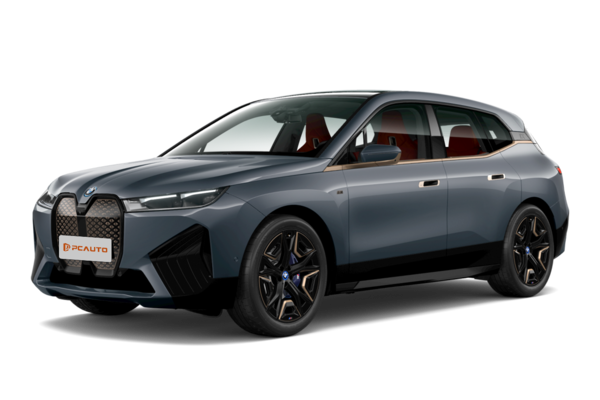Q
Where is the BMW iX M60 made?
The BMW iX M60 is manufactured in Germany. BMW is a renowned German automotive manufacturer, and its vehicles are typically produced in Germany factories. German manufacturing is known for its high quality, precision, and advanced engineering, which are hallmarks of BMW's production processes. The company's factories are equipped with state-of-the-art technology and staffed by skilled workers who ensure each vehicle meets BMW's stringent standards. The BMW iX M60 benefits from this manufacturing excellence, with features such as its advanced electric drivetrain, robust build quality, and luxurious interior working together to create a premium vehicle. Moreover, German manufacturing also enables efficient production and quality control, ensuring that Malaysian customers who purchase the BMW iX M60 receive a top-tier product.
Special Disclaimer: This content is published by users and does not represent the views or position of PCauto.
Related Q&A
Q
Does the BMW iX M60 have air suspension?
The BMW iX M60 does not have air suspension. It is equipped with a double-wishbone independent suspension at the front and a multi-link independent suspension at the rear. These suspension systems are designed to achieve an optimal balance between ride comfort and handling performance. The front double-wishbone suspension effectively manages forces acting on the wheels during cornering and braking, enhancing steering precision. The rear multi-link suspension helps maintain stability and ride quality, adapting well to various road conditions. While air suspension in some other models offers adjustable ride height and damping characteristics to improve comfort and performance, the iX M60 focuses on the capabilities of its standard suspension setup to deliver a smooth and controlled driving experience.
Q
What's the weight of BMW iX M60?
A BMW iX M60 weighs 2,585 kg. Its weight is influenced by multiple factors, such as its large dimensions of 4,953 mm in length, 1,967 mm in width, and 1,969 mm in height, with a wheelbase of 3,000 mm. Its all-wheel-drive system with two permanent magnet synchronous motors also increases the weight. The vehicle's lithium-iron-phosphate battery, with a capacity of 111.5 kWh, significantly impacts the overall weight, as EV batteries are typically heavy. Additionally, robust safety and comfort features—such as a comprehensive airbag system, multi-zone climate control, and a premium audio system—further increase its total mass. This weight does not necessarily affect performance; in fact, the BMW iX M60 can reach a top speed of 250 km/h and accelerate from 0 to 100 km/h in just 3.8 seconds.
Q
What is the specification of the BMW iX M60 motor?
The BMW iX M60 is powered by permanent magnet synchronous motors. It adopts a dual-motor setup with front and rear placement. The motor specifications include a maximum output of 619 horsepower, with a combined power of 455 kW and peak torque of 1,110 N·m. These potent motors enable exceptional dynamic performance, allowing the vehicle to accelerate from 0 to 100 km/h in just 3.8 seconds (as officially claimed) and reach a top speed of 250 km/h.
The all-wheel-drive system enhances BMW iX M60's traction and handling performance across various road conditions. The combination of these motor parameters and the drivetrain delivers a smooth, powerful, and efficient driving experience, making the BMW iX M60 a perfect choice for those consumers seeking a high-performance electric executive sedan.
Q
What's the top speed of the iX M60?
The BMW iX M60 has a top speed of 250 km/h, which shows the excellence of its powertrain system. Equipped with dual motors - specifically permanent magnet synchronous motors - working together to deliver exceptional power output, the iX M60 achieves such top speed through its 619 horsepower, 455 kW combined system power, and remarkable 1,110 N·m of torque.
The outstanding top speed not only delivers enjoyable driving experience but also shows BMW's engineering excellence in the electric vehicle domain. The vehicle's suspension and braking systems - including the front double-wishbone independent suspension, rear multi-link independent suspension, and ventilated disc brakes throughout - are specifically designed to handle the forces and demands of high-speed operation, ensuring both safety and handling precision are maintained even at maximum velocity.
Q
What are the differences between the iX M60 and M70?
There are several differences between the BMW iX M60 and M70. In terms of power performance, the iX M60's electric motor delivers a maximum output of 619PS, while the M70 generates a more powerful performance of 650 horsepower. Regarding exterior design, the new iX's closed front grille features a revised surface pattern that has changed from diamond to diagonal design, while the M70 adopts horizontal slat details similar to those on the new BMW M3/M4. Besides that, an LED surround light strip has been added to the front grille as standard equipment on the M70, while being optional for other variants. For wheels, the new BMW iX is equipped with 20-inch rims, with 21-inch and 22-inch options available, while the M70 introduces an optional 23-inch rim for the first time. In terms of range, the iX M60 has an official pure-electric range of 561km, while the M70 is estimated to achieve 302 miles (approximately 486km). Inside, the new BMW iX adopts a redesigned three-spoke circular steering wheel, replacing the previous polygonal two-spoke design. Additionally, the M70's M multifunction seats feature revised lateral bolstering and come equipped with a new heat pump air conditioning system, potentially casuing differences in overall configuration and driving experience.
Q
Is the BMW iX M60 equipped with All Wheel Drive system?
Yes, the BMW iX M60 is equipped with All Wheel Drive (AWD). It is powered by a dual-motor setup with a Front+Rear (front and rear) motor layout, which enables all-wheel drive. The all-wheel drive system makes the power distribution of the vehicle more flexible, allowing all four wheels to receive driving force. On slippery roads, such as in rainy or snowy conditions, all-wheel drive can significantly improve the vehicle's traction and stability, making the vehicle's driving safer and more reliable. During acceleration, all-wheel drive can better transfer power to the road surface, fully enabling the vehicle's power performance and achieving more rapid acceleration. Therefore, the all-wheel drive system of the BMW iX M60 brings drivers a better driving experience and adaptability in various road conditions.
Q
What are the differences between BMW iX M60 and xDrive50?
The BMW iX M60 differs from the xDrive50 in many aspects. In terms of power performance, the iX M60's electric motor shows more powerful output and quicker accerleration with a maximum output of 619PS, total power rated at 455kW, peak torque reaching 1,110N·m and official 0-100km/h acceleration time of 3.8 seconds, while the xDrive50 generates 523 horsepower and achieves the acceleration in 4.6 seconds. Regarding range, the iX M60's official pure-electric range reaches 561km, whereas the xDrive50's WLTP-certified range extends up to 630km. In addition, the drag coefficient measures 0.26Cd for the iX M60 compared to the xDrive50's 0.25Cd. In terms of price, the iX M60 is Priced at RM 579,800. What's more, in exterior design details, as the model of M Performance, the iX M60 adopts blue brake calipers with M badging, showing a more athletic and sophisticated appearance. Both models offer unique features, your selection can be based on your priorities for performance, range, and other factors.
Q
How long does it take to fully charge the BMW iX M60?
The BMW iX M60, as a high-performance all-electric SUV equipped with a large-capacity battery pack and fast-charging technology, its charging time depends on the charging method. When using a 50kW public fast charger, charging the battery from 10% to 80% takes approximately 1 hour and 30 minutes. With a more powerful 200kW fast-charging station, the same charging range can be achieved in about 35 minutes. For overnight slow-charging using an 11kW AC home wallbox, a full charge typically requires 10-11 hours.
Notably, to protect battery longevity, BMW's charging management system automatically reduces charging speed after reaching 80% capacity (particularly during high-power fast charging). Therefore, for long-distance travel, it's recommended to discontinue charging at 80% as this already provides sufficient range.
Q
What is the actual range of the BMW iX M60?
The official pure-electric cruising range of the BMW iX M60 is 561 kilometers. However, in actual use, its real cruising range is affected by various factors. For example, driving habit is an important factor. If the driving style is aggressive, with frequent rapid acceleration and sudden braking, the power consumption will increase and the cruising range will be shortened; smooth driving helps to improve the cruising performance. Road conditions are also a crucial factor. Frequent start-stop cycles in congested road or uphill driving increase the vehicle's energy consumption and reduce the cruising range, whereas on unobstructed highways or urban expressways, the cruising range is relatively closer to the official data. Additionally, temperature impacts its cruising range. In cold weather, battery performance declines, reducing the cruising range. In hot weather, prolonged use of air conditioning also consumes power and shortens the cruising range. In summary, the combination of multiple factors results in differences between the actual cruising range and the official data.
Q
How fast is the speed of BMW iX M60?
The speed of BMW iX M60 is quite fast. Its top speed is 250 km/h, which allows it to reach high velocities on suitable roads. Regarding acceleration, it can accelerate from 0 to 100 km/h in just 3.8 seconds. This quick acceleration is caused by its powerful electric drivetrain, which consists of two Permanent Magnet Synchronous Motors. These motors work together to produce a combined system output of 619 horsepower and 1110 N·m of torque.Therefore, BMW iX M60 can rapidly gain speed, providing an exciting driving experience. The iX M60's excellent speed performance helps drivers a lot whether for overtaking on the highway or merging into traffic. This kind of performance is especially impressive for an SUV that weighs 2585 kg, showing the advanced engineering of BMW's electric vehicle technology.
Popular Cars
Model Year
Car Compare
Car Photo
Latest Q&A
Q
How reliable is a 2019 Porsche Macan?
The 2019 Porsche Macan delivers solid reliability, thanks to its proven 2.0T or 3.0T engines that offer consistent power delivery. The PDK dual-clutch transmission is another strong point—it’s both durable and buttery-smooth.
Porsche’s sporty DNA shines through in the Macan’s chassis tuning and all-wheel-drive system, yet it doesn’t compromise everyday comfort. Owner feedback suggests that sticking to the factory maintenance schedule keeps most examples running trouble-free, though be prepared for higher upkeep costs (as with any luxury vehicle).
Its strong resale value speaks volumes about its reputation for dependability. If you’re after driving thrills without sacrificing SUV practicality, the 2019 Macan is a compelling pick. Just be sure to get a pre-purchase inspection and verify full service history—it’ll pay off in the long run.
Q
How much is a 2019 Porsche worth?
The value of a 2019 Porsche depends on the model, mileage, condition, and specs. Take the popular Cayenne, for example—used ones typically go for between RM300k to RM500k. A 911 Carrera might range from RM500k to RM800k, while an entry-level 718 Boxster or Cayman could be around RM250k to RM400k. For luxury sedans like the Panamera, expect prices between RM350k to RM600k, but always check the actual condition and option list.
Porsches hold their value well, especially limited editions or high-performance GT models, but maintenance costs and service history play a big role in resale pricing. If you're buying, stick to official certified pre-owned channels or get a professional inspection. Always verify warranty transfers and repair records.
Pro tip: Compare listings on local used-car platforms and check recent sales data—market demand and inventory fluctuations affect pricing. Also, factory options (like sport packages or premium audio) can boost resale value, while accident history or multiple owners might slash the price by 10-20%.
Q
Does the 2019 Macan have a good sound system?
The 2019 Porsche Macan delivers an impressive audio performance, particularly with the optional Bose® Surround Sound System or the top-tier Burmester® High-End Surround Sound System—both offering an immersive listening experience.
The Bose® setup packs 14 speakers with 665 watts of total power, delivering crisp audio and punchy bass perfect for pop and electronic music. Meanwhile, the Burmester® system steps it up with 16 speakers and 1,000 watts, creating a wider soundstage and superior detail reproduction—ideal for classical or high-resolution tracks.
Both systems integrate seamlessly with Porsche’s standard Communication Management (PCM), supporting Apple CarPlay and multiple audio sources. If sound quality is a priority, be sure to specify your audio preference at purchase—the base model only comes with a standard speaker setup.
For the best performance, play lossless files via USB or high-quality Bluetooth codecs, and keep the system firmware updated for optimal operation.
Q
What is the resale value of a 2019 Macan?
The resale value of a 2019 Porsche Macan depends on factors like condition, mileage, specs, and service history. Current used prices hover between RM250k to RM350k, with higher trims commanding premium prices. As Porsche's entry SUV, the Macan holds its value better than most rivals thanks to brand prestige and sporty DNA – especially models optioned with Sport Chrono or full leather interiors fetching stronger money.
Pro tip: Get a pre-sale inspection and organize your maintenance paperwork – this really helps maximize resale. Macans move quickly in our local used market, with 3-5 year-old examples being the sweet spot when depreciation levels off. If you're upgrading, consider Porsche Approved Certified pre-owned – you'll pay a slight premium over private sales, but the extended warranty and factory refurbishment save headaches down the road.
Q
Is a 2019 Porsche Macan a good car?
The 2019 Porsche Macan is a well-rounded luxury SUV that stays true to Porsche's performance DNA while delivering everyday practicality. It comes with your choice of a peppy 2.0T or more powerful 3.0T engine, paired with Porsche's brilliant 7-speed PDK transmission that shifts like butter. The chassis strikes that sweet spot between sporty handling and comfortable cruising - perfect for both city commutes and weekend backroad blasts.
Inside, you'll find Porsche's typical top-notch craftsmanship with a standard 10.9-inch touchscreen featuring Apple CarPlay. Just don't expect limo-like rear legroom. These things hold their value surprisingly well, though maintenance will cost you more than your average SUV - but then again, you get Porsche's excellent service network.
Among its competitors, the Macan stands out for its driver engagement. If you want more grunt, step up to the Macan S or GTS. One pro tip: if you're shopping used, pay special attention to the PDK's condition and inspect the suspension components. Always better to go through Porsche's certified pre-owned program for that extended warranty peace of mind.
View MoreRelated News

Audi RS6 sedan version may return to compete fully with the BMW M5
WilliamNov 21, 2025

Neue Klasse platform's first mass-produced vehicle, the all-new BMW iX3 makes its debut, looks just like a concept car
LienSep 8, 2025

BMW X5 will become BMW's first model equipped with a hydrogen fuel cell, with a range of 504 kilometers
JamesSep 8, 2025

BMW's all-new iX3 to be unveiled on September 5, built on the Neue Klasse platform
Kevin WongSep 1, 2025

BMW to Debut Limited-Edition 8 Series at Monterey Car Week
AshleyJul 31, 2025
View More

















Pros
Cons